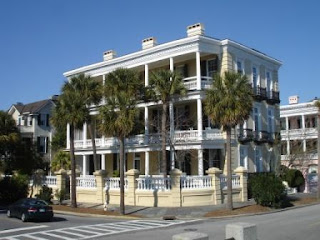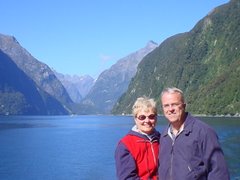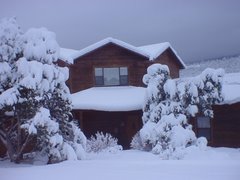We close up and head west ASAP. Not far into TX, after not much more than an hour of driving, we encounter fog. It’s a misty fog that freezes on the windshield. Quickly. Becomes more of a drizzle. Wipers, defroster, and de-icing fluid aren’t enough to keep Tuzi’s big front windshield clear. Particularly troublesome is ice that blocks my view of the rearview mirrors. We plug in our electric space heaters and hold them up to the windshield. We drive exit to exit for a while, stopping at each to scrape and melt ice. Finally, at the Alanreed exit, where there is a general store, liquor store, deli (they sell packaged sandwiches), motel, filling station, Route 66 gift shop, and post office, all collocated and all belonging, it appears, to the same owner – anyhow, for any of those services you pay the same nice lady – we decide to stop for the duration. (Alanreed’s motto is: See Alanreed, all from one spot. I should have asked if Alan is home.) I hadn't realized there was a campground when I pulled in. Primarily, I was just going to buy some de-icing fluid. The word from Amarillo, 60 miles down the road, from the nice lady in the Alanreed general store, our Amarillo friends - the Sooters - and travelers from that direction, is that the fog is thick and roads are getting icy.
I ask, Do you have a campground? Nice lady says Yes, we do! (my exclamation point). We’re in no hurry and there’s no reason to take risks, so we pull into the campground (maybe five sites) and hook up. We’ve got a 3/4 full propane tank, 50 amps of power, and satellite TV to keep us warm and entertained.
Because of the continuing freezing drizzle we decide not to open the slide-outs. If ice built up on the awnings that extend over the slide-outs, that could be a problem and if ice got into the mechanisms, we might not be able to close the slide-outs until the spring thaw. Also, there’s less space to heat with the slide-outs closed. We’ve each got our own space. I’ve got the front TV and reclining chair. Susie’s got the back TV and bed. We’ve each got space heaters that we can conveniently aim and thus not use the furnaces to heat the whole interior space.
Late in the afternoon another motor home pulls into the campground. The driver hoped to get to Indianapolis by Thursday to do some work (work ?) there. But between Amarillo and here he saw an overturned semi and decided that was enough. On the Weather Channel most of the ice-storm attention is focused on further east, so things are definitely not going to get better for him as he goes.
Tuesday. It’s still cold (11 in Amarillo) and apparently icy, though semis are rolling at moderate speed on I-40. No other traffic that I can see, though. Tuzi’s got a nice coating of ice on the windward side. Roy Sooter calls from Amarillo and says the word there is don’t drive if it’s not necessary. Also, when I walk over to get a newspaper, the parking lot is ice-coated. So, we sit another day. Hoped it might clear up by mid-day, but it didn’t. So, we’ll spend Tuesday bundled up here. By evening, though, there is a little sunshine and a nice sunset. Forecast is promising for tomorrow. We’ve got enough propane for another night, so no problem. Getting a little low on water, but the only way to get more water into our tank is to move to another slot, with a still-functioning spigot. That’s too much trouble and we’ll be OK if we skip the showers, I fearlessly claim, so we stay put.
So, too, is our Indy-bound neighbor. I visited him briefly and he said his furnace quit during the night. He was up around 5 am working on that. While the furnace was out his water lines froze somewhere, so they were without water and he was trying to find the right place to apply some heat. Of course, we can buy drinking and toothbrushing water from the general store, or, if worse comes to worse, rent a motel room if our motorhome systems don’t work. They and I (not Susie, though – she has her standards) can also use the general store’s bathrooms, so I don’t offer them a share of our dwindling water.
It's good we stopped where we did, and fortuitous. I don't think there are any RV parks in the 60 miles from Alanreed to Amarillo. There is a nice visitors center not far down the road and we probably could have done a day there using power from our diesel generator, but we wouldn't have had a walk-to grocery and gift shop.
When I went up to the Alanreed command post for some provisioning, I browsed a Route 66 guidebook. There were a couple of pages on Alanreed and I learn that the nice lady in charge is named Dixie Crockett. I take it that Route 66 afficionados know her or know of her. I buy a postcard and she autographs it.
Here is an Alanreed picture from the above link:

I remember stopping here once on a previous Tuzitrip to get gas. The price was outrageous and the driveway out of the station was a mess - potholes, broken pavement. Vowed never again, but conditions change. Now the station's price display, where all travelers can see it, shows last summer's prices - $3 plus for gas, $4 plus for diesel. The pumps, though, show current prices.
By the end of Tuesday, we’re both getting a case of cabin fever, as Susie says, the fidgets. I’ve run out of books to read. I’ve played a lot of Palmpilot Scrabble and solitaire. I write up our days here for eventual posting. I know I should/could be working on my class notes or textbook, but can’t get motivated. Susie reads and watches TV. Every once in a while when we turn too many electrical things on, I have to go outside and reset the breaker. We’re on 50 amps, but still cross that threshold occasionally.
The day’s saddest words: No wireless networks within range.
Here's the Texas panhandle scene:

Wednesday. Sunshine!

We bid farewell to Alanreed and Miss Dixie. I-40 has been sanded and it's clear. We head for home - 340 miles. When you're within a day of home, it's hard to resist. After Amarillo there's no sign of previous ice. We've dropped our plans to go by Corona, NM, to see Susie's brother. Charlie and Sue are in Albuquerque this day. You may recall, you persistent readers, that we started this trip by dropping plans to go by Corona. Also, more deja vu, in NM we encounter a strong crosswind from the north, as on Day One, but not so fierce. We stop in Tucumcari for a pig-out lunch at the Flying J's Country Market buffet (New Year's resolutions kick in tomorrow). The weather's much warmer there than where we've come from. We've been shedding ice from Tuzi all along the way.
Here's the traditional almost home picture through the windshield:

Between Cline's Corners and Moriarty (say 40 miles from home) a semi pulls alongside and the driver gestures, pointing down, I think. Oh, No! What could be wrong? More deja vu. I pull over and check tires, Tuzi, even on top, and the Explorer. Can't find anything dangling or damaged. A couple of basement compartment doors are not latched. They can't really swing open, but I suppose wind gusts could cause them to lift and fall occasionally. However, it's unlikely anything could fall out. Nothing is missing. The doors were probably frozen in the morning when I made my pre-departure check. Anyhow, we proceed and nobody else has any issues with us. We get home around 3:30, unload just the essentials, and make ourselves at HOME.
It's been a great trip, even with the problems we encountered. Susie gets teary just thinking about the family cruise. A very special time for all of us. Odometer says Tuzi covered 4700 miles.
Cheers,
Susie and Rob
































































